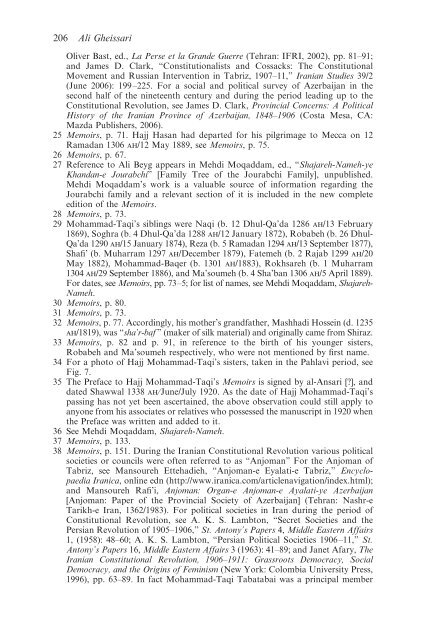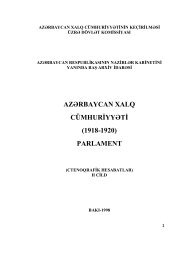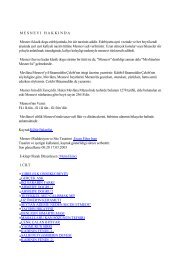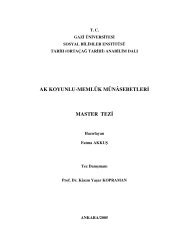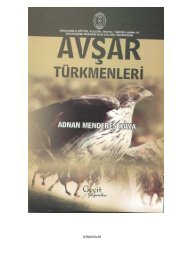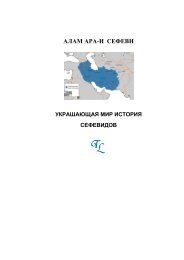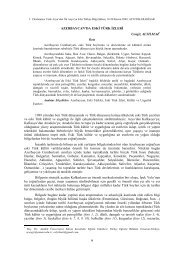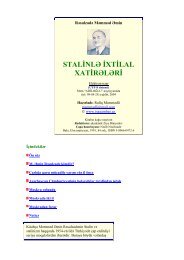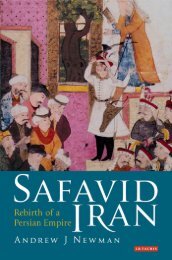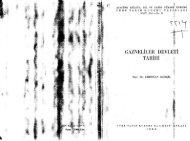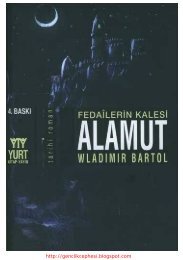Merchants without frontier 20516 Memoirs, p. 158.17 Memoirs, pp. 45–63. What Hajj Mohammad-Taqi seems to be do<strong>in</strong>g at the outsetof writ<strong>in</strong>g the Memoirs is, <strong>in</strong> effect, attempt<strong>in</strong>g to establish his own uprightmoral/ethical st<strong>and</strong>ards. In other words, he already has some future audience <strong>in</strong>m<strong>in</strong>d – friends, descendants, or a larger readership – for whom, with dialogic <strong>in</strong>tent,he is writ<strong>in</strong>g. His discussion of his own moral rectitude clearly underscores thefact that the “memoirs” was not simply a “personal diary” <strong>in</strong> the narrowest senseof the term but was <strong>in</strong>tended to be read by others. A further parallel may alsobe drawn here with the long Iranian <strong>and</strong> Islamic traditions of moral/ethical writ<strong>in</strong>gs<strong>and</strong> discursive practices.18 Memoirs, p. 54.19 Yafeth is the same as Japheth of the Bible (see, for example, Genesis 9:18–27,10:1–2) associated with the well-known <strong>and</strong> often illustrated episode of thenakedness of Noah (when he became drunk <strong>and</strong> collapsed <strong>in</strong> a naked state).However, there is a conflict usually between Biblical sources <strong>and</strong> commentarieson the Qur’an (which often rely heavily on material outside the Qur’an). In theBible Yafeth <strong>and</strong> his brother Shem cover Noah’s nakedness, but accord<strong>in</strong>g to TafsireSourabadi (ed. Ali-Akbar Sa’idi Sirjani (Tehran 2001)), a widely consulted <strong>Persia</strong>ncommentary on the Qur’an, for example, Yafeth backs Ham, the father of Canaan,who had laughed at Noah’s nakedness <strong>and</strong> was subsequently cursed by Noah.Ya’juj <strong>and</strong> Ma’juj (Gog <strong>and</strong> Magog) <strong>and</strong> other “<strong>in</strong>fidels” are all considered tohave been issued from Yafeth’s l<strong>in</strong>eage. There are recurrent references to Yafeth<strong>in</strong> classical <strong>Persia</strong>n texts, mostly <strong>in</strong> pass<strong>in</strong>g.20 Memoirs, p. 60. This is particularly <strong>in</strong>dicative of Hajj Mohammad-Taqi’s occasionalreferences to his <strong>in</strong>terest <strong>in</strong> religious education, such as dur<strong>in</strong>g pilgrimages.He is <strong>in</strong> effect also attempt<strong>in</strong>g to demonstrate his comm<strong>and</strong> of religious knowledge,<strong>and</strong>, hence, his overall erudition. Furthermore, a measured sense of selfaggr<strong>and</strong>izementcan be noted here too, given that he could count himself as amongthe talented people because of his pursuit of commerce.21 Memoirs, p. 59.22 The Iranian civil war between constitutional <strong>and</strong> anti-constitutional forcesfirst broke out <strong>in</strong> Azerbaijan, <strong>and</strong> subsequently spread to Gilan <strong>and</strong> Isfahanprov<strong>in</strong>ces, last<strong>in</strong>g from the summer of 1908 to the summer of 1909 <strong>and</strong> culm<strong>in</strong>at<strong>in</strong>g<strong>in</strong> the constitutionalist march on Tehran <strong>and</strong> the overthrow ofMohammad-Ali Shah.23 The event culm<strong>in</strong>ated on Saturday 28 Rabi’ I 1328 ah/9 April 1910, <strong>in</strong> the Sham-Gh<strong>az</strong>an area <strong>in</strong> the western part of Tabriz. Sham-Gh<strong>az</strong>an (also known as Shanb-Gh<strong>az</strong>an as well as Gh<strong>az</strong>anieh, <strong>and</strong> sometimes pronounced “Sham<strong>az</strong>an” [sic]), refersto the historical site of the mausoleum built <strong>in</strong> 702 ah/1302 by the Il-Khanid rulerGh<strong>az</strong>an Khan (r. 1295–1304), see the entry on “Sham-Gh<strong>az</strong>an,” <strong>in</strong> MohammadMo<strong>in</strong>, Farhang-e Farsi [<strong>Persia</strong>n Dictionary], vol. 5, 5th edn (Tehran: Amir-Kabir,1362/1983), pp. 873–4; for additional <strong>and</strong> detailed <strong>in</strong>formation, see Rashid al-D<strong>in</strong> F<strong>az</strong>lollah, Tarikh-e Mobarak-e Gh<strong>az</strong>ani, ed. Karl Jahn, Gibb Memorial Series(London, 1940); see also, Laurence Lockhart, Famous Cities of Iran (Brentford,Middlesex: Walter Pearce & Co., 1939), pp. 19–23, note <strong>in</strong> particular p. 20;<strong>and</strong> Donald N. Wilber, The Architecture of Islamic Iran: The Il-Khanid Period(New York: Greenwood Press, 1969), pp. 124–6. For images of some historicalbuild<strong>in</strong>gs of Tabriz, see Mokhtar Hadidi, “Tabriz <strong>az</strong> Daricheh-ye Tasavir-eAhd-e <strong>Qajar</strong>ieh” [Tabriz <strong>in</strong> the Photographs of the <strong>Qajar</strong> Period], Baharestan, onl<strong>in</strong>ejournal of the Institute for Iranian Contemporary Historical Studies (IICHS),available at: (http://www.iichs.org/Baharestan/bahar26/<strong>az</strong>khak.html).24 This section was published first, see note 11, above. For Russian <strong>in</strong>terventions <strong>in</strong>Iran <strong>in</strong> general <strong>and</strong> Azerbaijan <strong>in</strong> particular, see, respectively, Saleh M. Aliev,“Significant Changes <strong>in</strong> Russian Expansionist Policy towards Iran (1906–17),” <strong>in</strong>
206 Ali GheissariOliver Bast, ed., La Perse et la Gr<strong>and</strong>e Guerre (Tehran: IFRI, 2002), pp. 81–91;<strong>and</strong> James D. Clark, “Constitutionalists <strong>and</strong> Cossacks: The ConstitutionalMovement <strong>and</strong> Russian Intervention <strong>in</strong> Tabriz, 1907–11,” Iranian Studies 39/2(June 2006): 199–225. For a social <strong>and</strong> political survey of Azerbaijan <strong>in</strong> thesecond half of the n<strong>in</strong>eteenth century <strong>and</strong> dur<strong>in</strong>g the period lead<strong>in</strong>g up to theConstitutional Revolution, see James D. Clark, Prov<strong>in</strong>cial Concerns: A PoliticalHistory of the Iranian Prov<strong>in</strong>ce of Azerbaijan, 1848–1906 (Costa Mesa, CA:M<strong>az</strong>da Publishers, 2006).25 Memoirs, p. 71. Hajj Hasan had departed for his pilgrimage to Mecca on 12Ramadan 1306 ah/12 May 1889, see Memoirs, p. 75.26 Memoirs, p. 67.27 Reference to Ali Beyg appears <strong>in</strong> Mehdi Moqaddam, ed., “Shajareh-Nameh-yeKh<strong>and</strong>an-e Jourabchi” [Family Tree of the Jourabchi Family], unpublished.Mehdi Moqaddam’s work is a valuable source of <strong>in</strong>formation regard<strong>in</strong>g theJourabchi family <strong>and</strong> a relevant section of it is <strong>in</strong>cluded <strong>in</strong> the new completeedition of the Memoirs.28 Memoirs, p. 73.29 Mohammad-Taqi’s sibl<strong>in</strong>gs were Naqi (b. 12 Dhul-Qa’da 1286 ah/13 February1869), Soghra (b. 4 Dhul-Qa’da 1288 ah/12 January 1872), Robabeh (b. 26 Dhul-Qa’da 1290 ah/15 January 1874), Reza (b. 5 Ramadan 1294 ah/13 September 1877),Shafi’ (b. Muharram 1297 ah/December 1879), Fatemeh (b. 2 Rajab 1299 ah/20May 1882), Mohammad-Baqer (b. 1301 ah/1883), Rokhsareh (b. 1 Muharram1304 ah/29 September 1886), <strong>and</strong> Ma’soumeh (b. 4 Sha’ban 1306 ah/5 April 1889).For dates, see Memoirs, pp. 73–5; for list of names, see Mehdi Moqaddam, Shajareh-Nameh.30 Memoirs, p. 80.31 Memoirs, p. 73.32 Memoirs, p. 77. Accord<strong>in</strong>gly, his mother’s gr<strong>and</strong>father, Mashhadi Hosse<strong>in</strong> (d. 1235ah/1819), was “sha’r-baf ” (maker of silk material) <strong>and</strong> orig<strong>in</strong>ally came from Shir<strong>az</strong>.33 Memoirs, p. 82 <strong>and</strong> p. 91, <strong>in</strong> reference to the birth of his younger sisters,Robabeh <strong>and</strong> Ma’soumeh respectively, who were not mentioned by first name.34 For a photo of Hajj Mohammad-Taqi’s sisters, taken <strong>in</strong> the Pahlavi period, seeFig. 7.35 The Preface to Hajj Mohammad-Taqi’s Memoirs is signed by al-Ansari [?], <strong>and</strong>dated Shawwal 1338 ah⁄June/July 1920. As the date of Hajj Mohammad-Taqi’spass<strong>in</strong>g has not yet been ascerta<strong>in</strong>ed, the above observation could still apply toanyone from his associates or relatives who possessed the manuscript <strong>in</strong> 1920 whenthe Preface was written <strong>and</strong> added to it.36 See Mehdi Moqaddam, Shajareh-Nameh.37 Memoirs, p. 133.38 Memoirs, p. 151. Dur<strong>in</strong>g the Iranian Constitutional Revolution various politicalsocieties or councils were often referred to as “Anjoman” For the Anjoman ofTabriz, see Mansoureh Ettehadieh, “Anjoman-e Eyalati-e Tabriz,” EncyclopaediaIranica, onl<strong>in</strong>e edn (http://www.iranica.com/articlenavigation/<strong>in</strong>dex.html);<strong>and</strong> Mansoureh Rafi’i, Anjoman: Organ-e Anjoman-e Ayalati-ye Azerbaijan[Anjoman: Paper of the Prov<strong>in</strong>cial Society of Azerbaijan] (Tehran: Nashr-eTarikh-e Iran, 1362/1983). For political societies <strong>in</strong> Iran dur<strong>in</strong>g the period ofConstitutional Revolution, see A. K. S. Lambton, “Secret Societies <strong>and</strong> the<strong>Persia</strong>n Revolution of 1905–1906,” St. Antony’s Papers 4, Middle Eastern Affairs1, (1958): 48–60; A. K. S. Lambton, “<strong>Persia</strong>n Political Societies 1906–11,” St.Antony’s Papers 16, Middle Eastern Affairs 3 (1963): 41–89; <strong>and</strong> Janet Afary, TheIranian Constitutional Revolution, 1906–1911: Grassroots Democracy, SocialDemocracy, <strong>and</strong> the Orig<strong>in</strong>s of Fem<strong>in</strong>ism (New York: Colombia University Press,1996), pp. 63–89. In fact Mohammad-Taqi Tabatabai was a pr<strong>in</strong>cipal member
- Page 2 and 3:
War and Peace in Qajar PersiaPersia
- Page 4 and 5:
War and Peace inQajar PersiaImplica
- Page 6 and 7:
ContentsList of figuresContributors
- Page 8 and 9:
Figures5.1 Omani enclaves 1305.2 Ar
- Page 10 and 11:
Contributor listMansoureh Ettehadie
- Page 12:
AcknowledgementsThis volume grew ou
- Page 15 and 16:
2 Roxane Farmanfarmaianrepresented
- Page 17 and 18:
4 Roxane Farmanfarmaianchapter in t
- Page 19 and 20:
6 Roxane FarmanfarmaianThus, two si
- Page 21 and 22:
8 Roxane Farmanfarmaiangaining grea
- Page 23 and 24:
10 Roxane Farmanfarmaiantough deals
- Page 25 and 26:
12 Roxane FarmanfarmaianIranian geo
- Page 27 and 28:
14 Peter W. Averyin Shiraz and cont
- Page 29 and 30:
16 Peter W. Averybut the invasion w
- Page 32:
Part IWar
- Page 35 and 36:
22 Manoutchehr M. Eskandari-Qajarth
- Page 37 and 38:
24 Manoutchehr M. Eskandari-Qajarap
- Page 39 and 40:
26 Manoutchehr M. Eskandari-Qajarmi
- Page 41 and 42:
28 Manoutchehr M. Eskandari-Qajarth
- Page 43 and 44:
30 Manoutchehr M. Eskandari-Qajardo
- Page 45 and 46:
32 Manoutchehr M. Eskandari-QajarIn
- Page 47 and 48:
34 Manoutchehr M. Eskandari-Qajarco
- Page 49 and 50:
36 Manoutchehr M. Eskandari-QajarTh
- Page 51 and 52:
38 Manoutchehr M. Eskandari-Qajarth
- Page 53 and 54:
40 Manoutchehr M. Eskandari-Qajarth
- Page 55 and 56:
42 Manoutchehr M. Eskandari-Qajarop
- Page 57 and 58:
44 Manoutchehr M. Eskandari-Qajarbe
- Page 59 and 60:
46 Manoutchehr M. Eskandari-Qajarva
- Page 61 and 62:
48 Stephanie Cronincapacity and res
- Page 63 and 64:
50 Stephanie Croninforces of the es
- Page 65 and 66:
52 Stephanie CroninPART ONE: THE QA
- Page 67 and 68:
54 Stephanie Croninprincipally on h
- Page 69 and 70:
56 Stephanie CroninThe French offic
- Page 71 and 72:
58 Stephanie CroninEuropean alignme
- Page 73 and 74:
60 Stephanie Croninthe authorities
- Page 75 and 76:
62 Stephanie Croninin the revolutio
- Page 77 and 78:
64 Stephanie Croninof power and sta
- Page 79 and 80:
66 Stephanie Croninliving and the m
- Page 81 and 82:
68 Stephanie Croninconsequences for
- Page 83 and 84:
70 Stephanie Croninrevolution was a
- Page 85 and 86:
72 Stephanie CroninNew British miss
- Page 87 and 88:
74 Stephanie CroninBrigade to a Div
- Page 89 and 90:
76 Stephanie Croninwithout the sove
- Page 91 and 92:
78 Stephanie Croninaccounting devic
- Page 93 and 94:
80 Stephanie Croninbut also faced a
- Page 95 and 96:
82 Stephanie Cronindetermined on th
- Page 97 and 98:
84 Stephanie Cronin15 For a discuss
- Page 99 and 100:
86 Stephanie Cronin55 The Anglo-Rus
- Page 101 and 102:
3 The Turko-Persian War1821-1823Win
- Page 103 and 104:
90 Graham WilliamsonThe resultant w
- Page 105 and 106:
92 Graham Williamsonprovincial forc
- Page 107 and 108:
94 Graham WilliamsonThe field armyO
- Page 109 and 110:
96 Graham Williamsonnot hold out mu
- Page 111 and 112:
98 Graham Williamsonoften in arrear
- Page 113 and 114:
100 Graham Williamsonthan any desig
- Page 115 and 116:
102 Graham WilliamsonThere were ove
- Page 117 and 118:
104 Graham Williamsonone should not
- Page 119 and 120:
Table 3.2 Persian regional armies (
- Page 121 and 122:
108 Graham WilliamsonIranian influe
- Page 123 and 124:
4 Social networks andborder conflic
- Page 125 and 126:
112 Vanessa MartinPersian troops on
- Page 127 and 128:
114 Vanessa Martinof comparatively
- Page 129 and 130:
116 Vanessa MartinTHE ROLE OF SOCIA
- Page 131 and 132:
118 Vanessa MartinThe Shah’s negl
- Page 133 and 134:
120 Vanessa Martinborder or any oth
- Page 135 and 136:
122 Vanessa Martin44 No. 38, 2 June
- Page 138 and 139:
5 The consolidation of Iran’sfron
- Page 140 and 141:
Consolidation of Iran’s frontier
- Page 142 and 143:
Consolidation of Iran’s frontier
- Page 144 and 145:
Consolidation of Iran’s frontier
- Page 146 and 147:
Consolidation of Iran’s frontier
- Page 148 and 149:
Consolidation of Iran’s frontier
- Page 150 and 151:
Figure 5.2 Arab principalities
- Page 152 and 153:
Consolidation of Iran’s frontier
- Page 154 and 155:
Consolidation of Iran’s frontier
- Page 156 and 157:
Consolidation of Iran’s frontier
- Page 158 and 159:
Consolidation of Iran’s frontier
- Page 160 and 161:
Consolidation of Iran’s frontier
- Page 162 and 163:
6 Narrowing the frontierMid-ninetee
- Page 164 and 165:
Narrowing the frontier 151witnessed
- Page 166 and 167:
Figure 6.1 The 1843 borderlands sta
- Page 168 and 169: Narrowing the frontier 155And the S
- Page 170 and 171: Figure 6.2 The 1850 Williams line a
- Page 172 and 173: Narrowing the frontier 159elicited
- Page 174 and 175: Narrowing the frontier 161travellin
- Page 176 and 177: Narrowing the frontier 163be found
- Page 178 and 179: Narrowing the frontier 165A similar
- Page 180 and 181: Narrowing the frontier 167and accep
- Page 182 and 183: Narrowing the frontier 169Perhaps t
- Page 184 and 185: Narrowing the frontier 171By this s
- Page 186 and 187: Narrowing the frontier 17346 For a
- Page 188 and 189: Crime, security, and insecurity 175
- Page 190 and 191: Crime, security, and insecurity 177
- Page 192 and 193: Crime, security, and insecurity 179
- Page 194 and 195: Crime, security, and insecurity 181
- Page 196 and 197: 8 Merchants without bordersTrade, t
- Page 198 and 199: Merchants without frontier 185the m
- Page 200 and 201: Merchants without frontier 187and d
- Page 202 and 203: Merchants without frontier 189photo
- Page 204 and 205: Merchants without frontier 191their
- Page 206 and 207: Merchants without frontier 193In an
- Page 208 and 209: Figure 8.1Seated, first from left:
- Page 210 and 211: Figure 8.3Seated: Hajj Mohammad-Taq
- Page 212 and 213: Figure 8.5 Taken in Hajj Hasan Jour
- Page 214 and 215: Merchants without frontier 201Figur
- Page 216 and 217: Merchants without frontier 203Studi
- Page 220 and 221: Merchants without frontier 207and t
- Page 222 and 223: Merchants without frontier 209or pu
- Page 224 and 225: Merchants without frontier 211It ca
- Page 226 and 227: 9 The politics of concessionReasses
- Page 228 and 229: The politics of concession 215gradu
- Page 230 and 231: The politics of concession 217Shah,
- Page 232 and 233: The politics of concession 219assig
- Page 234 and 235: The politics of concession 221compa
- Page 236 and 237: The politics of concession 223gross
- Page 238 and 239: The politics of concession 225the B
- Page 240 and 241: The politics of concession 227as th
- Page 242 and 243: IndexAbbas Mirza, Crown Prince 6, 1
- Page 244 and 245: Index 231Gulf Arabs 127-9Gwadar 136
- Page 246 and 247: Index 233policy in Persian Gulf 131


